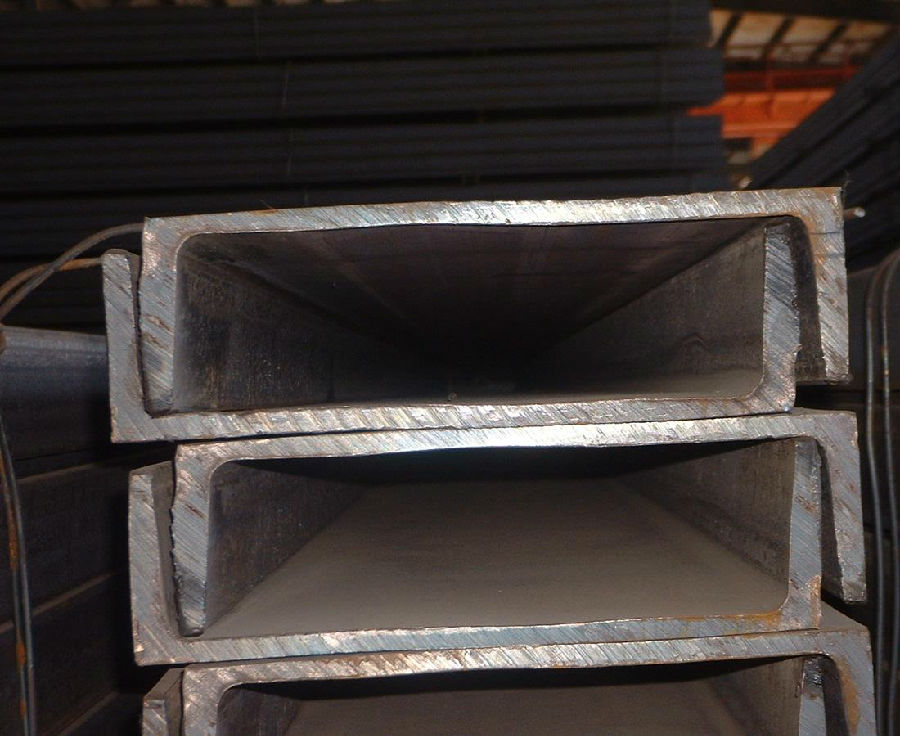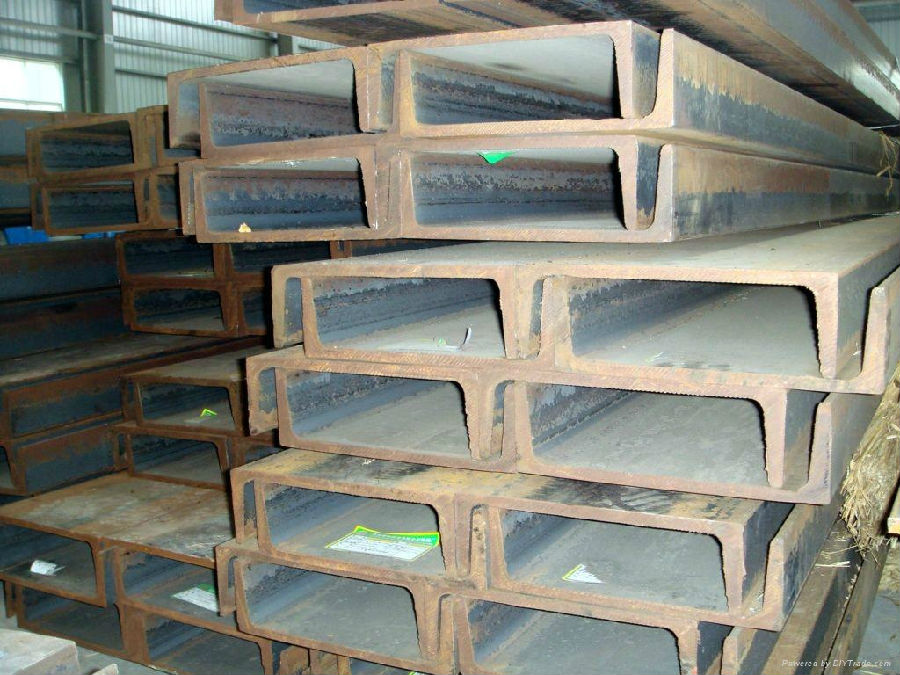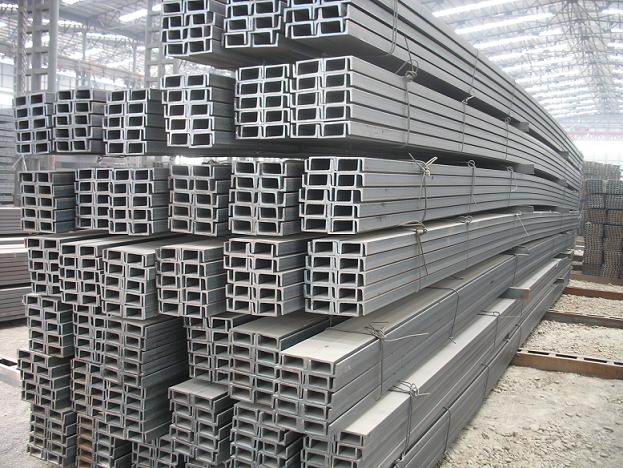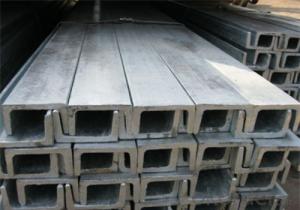JIS Standard Hot Rolled Channel Steel, carbon mild structural steel u channel
- Loading Port:
- Tianjin
- Payment Terms:
- TT OR LC
- Min Order Qty:
- 25 m.t.
- Supply Capability:
- 30000 m.t./month
OKorder Service Pledge
OKorder Financial Service
You Might Also Like
Steel Channel
1.Country of Origin: China
2.Commodity: Channel steel
3.Tolerance: Strictly according to the G/B and JIS standard
4.Delivery time: within 30 days
5.Price term: CIF/ CFR according to clients requirements
6.Payment terms: 100%Irrevercable L/C At Sight or TT
7. Length:6-12m



GB STANDARD STEEL CHANNEL BAR | ||||
SIZE | H(mm) | B(mm) | T(mm) | Kg/m |
5 | 50 | 37 | 4.5 | 5.438 |
6.3 | 63 | 40 | 4.8 | 6.634 |
8 | 80 | 43 | 5.0 | 8.045 |
10 | 100 | 48 | 5.3 | 10.007 |
12 | 120 | 53 | 5.5 | 12.059 |
14A | 140 | 58 | 6.0 | 14.535 |
14B | 140 | 60 | 8.0 | 16.733 |
16A | 160 | 63 | 6.5 | 17.240 |
16B | 160 | 65 | 8.5 | 19.752 |
18A | 180 | 68 | 7.0 | 20.174 |
18B | 180 | 70 | 9.0 | 23.000 |
20A | 200 | 73 | 7.0 | 22.637 |
20B | 200 | 75 | 9.0 | 25.777 |
22A | 220 | 77 | 7.0 | 24.999 |
22B | 220 | 79 | 9.0 | 28.453 |
25A | 250 | 78 | 7.0 | 27.410 |
25B | 250 | 80 | 9.0 | 31.335 |
28A | 280 | 82 | 7.5 | 31.427 |
28B | 280 | 84 | 9.5 | 35.823 |
30A | 300 | 85 | 7.5 | 34.463 |
30B | 300 | 87 | 9.5 | 39.173 |
32A | 320 | 88 | 8.0 | 38.083 |
32B | 320 | 90 | 10.0 | 43.107 |
36A | 360 | 96 | 8.0 | 47.814 |
36B | 360 | 98 | 110 | 53.166 |
40A | 400 | 100 | 10.5 | 58.928 |
40B | 400 | 102 | 12.5 | 65.208 |
JIS STANDARD CANNEL STEEL BAR | ||||
H(mm) | B(mm) | T1(mm) | T2(mm) | Kg/m |
75 | 40 | 3.8 | 7.0 | 5.30 |
75 | 40 | 4.0 | 7.0 | 5.60 |
75 | 40 | 4.5 | 7.0 | 5.85 |
75 | 40 | 5.0 | 7.0 | 6.92 |
76 | 38 | 5.1 | 6.8 | 6.70 |
100 | 50 | 3.8 | 6.0 | 7.30 |
100 | 50 | 4.2 | 6.0 | 8.03 |
100 | 50 | 4.5 | 7.5 | 8.97 |
100 | 50 | 5.0 | 7.5 | 9.36 |
102 | 51 | 6.1 | 7.6 | 10.42 |
125 | 65 | 5.2 | 6.8 | 11.66 |
125 | 65 | 5.3 | 6.8 | 12.17 |
125 | 65 | 5.5 | 8.0 | 12.91 |
125 | 65 | 6.0 | 8.0 | 13.40 |
127 | 64 | 6.4 | 9.2 | 14.9 |
150 | 75 | 5.5 | 7.3 | 14.66 |
150 | 75 | 5.7 | 10.0 | 16.71 |
150 | 75 | 6.5 | 10.0 | 18.60 |
150 | 75 | 9.0 | 12.5 | 24.00 |
152 | 76 | 6.4 | 9.0 | 17.90 |
- Q:What are the different surface finishes available for steel channels?
- Some of the different surface finishes available for steel channels include mill finish, hot-dip galvanized, painted, and powder-coated.
- Q:Is it OK to use the channel steel to do the Overhanging Scaffold? Is there any difference between the cantilever scaffold made of I-beam and channel steel?
- Yes, both I-beam and channel steel have specifications and models. As long as they can meet the load requirements, there is no difference between them.
- Q:How do steel channels perform under seismic loads?
- Steel channels are known for their excellent performance under seismic loads. The inherent strength and ductility of steel, combined with the structural characteristics of channels, make them highly resilient to seismic forces. Steel channels can effectively absorb and distribute the energy generated during an earthquake, reducing the potential for structural damage or collapse. Additionally, steel channels can be designed and reinforced with appropriate connections and bracing to enhance their seismic performance, ensuring the safety and stability of structures in earthquake-prone areas.
- Q:What are the different types of connections for steel channels in modular construction?
- Some of the different types of connections for steel channels in modular construction include bolted connections, welded connections, and bracket connections.
- Q:According to the standard, indoor hanging stone 3 meters high, whether to add channel?
- Dry hanging method of stone, also called hollow hanging method. "Stone hanging tools for special purposes, construction basket rental sales" is the current wall decoration in a new type of construction process. The method uses a metal pendant to hang the facing stone directly on the wall surface or hollow over the steel frame, without grouting and pasting. The principle is in the main structure is arranged on the main points, the metal Guajian stone will be fixed on the building, forming a decorative stone curtain wall.
- Q:Can steel channels be used in sports facility construction?
- Yes, steel channels can be used in sports facility construction. They are commonly used to provide support and structural integrity to various components of the facility, such as bleachers, scoreboards, and equipment racks. Steel channels offer strength, durability, and versatility, making them suitable for withstanding the demands of a sports facility environment.
- Q:How do steel channels contribute to the modular construction process?
- Steel channels are an essential component of the modular construction process as they provide structural support and stability to the modular units. These channels are typically made of high-quality steel, which offers excellent strength and durability. One way steel channels contribute to the modular construction process is by acting as a framework for the modular units. They are used to create the structural skeleton of the modules, ensuring that they can withstand the loads and stresses imposed on them during transportation and installation. The channels are precisely fabricated and assembled to form a rigid framework, allowing the modules to be easily transported and stacked together on-site. Additionally, steel channels enable the integration of various building systems within the modular units. They provide a secure base for the installation of electrical wiring, plumbing, and HVAC systems. By incorporating these channels into the design, the modules can be pre-wired and pre-plumbed, minimizing on-site labor and accelerating the overall construction process. Furthermore, steel channels offer flexibility and adaptability in the modular construction process. They can be easily modified or extended to accommodate changes or additions to the modular units. This allows for efficient customization and flexibility in design, enabling the modules to meet specific project requirements. In terms of sustainability, steel channels contribute to the eco-friendliness of modular construction. Steel is a highly recyclable material, and the use of steel channels in modular construction reduces waste and promotes resource efficiency. Additionally, the durability of steel channels ensures that the modular units have a long lifespan, reducing the need for frequent replacements and minimizing the environmental impact. Overall, steel channels play a crucial role in the modular construction process by providing structural support, facilitating the integration of building systems, offering flexibility in design, and promoting sustainability. Their contribution ultimately leads to faster construction timelines, improved quality, and cost-effectiveness in the modular construction industry.
- Q:What is the weight per meter of different steel channel sizes?
- The weight per meter of different sizes of steel channels can fluctuate based on the distinct dimensions and thickness of the channels. When assessing steel channels, their height, width, and thickness are typically measured. To determine the weight per meter, you will need knowledge of the dimensions and density of the particular steel type being employed. The weight per meter can be determined by multiplying the cross-sectional area of the channel by the steel's density. For instance, let's presume we possess a steel channel with dimensions of 100mm (height) x 50mm (width) x 6mm (thickness), and the steel's density is 7.85 grams per cubic centimeter (g/cm³). Initially, let's convert the dimensions to meters: Height = 100mm = 0.1m Width = 50mm = 0.05m Thickness = 6mm = 0.006m Subsequently, compute the cross-sectional area: Area = Height x Width = 0.1m x 0.05m = 0.005 square meters (m²) Lastly, ascertain the weight per meter: Weight per meter = Area x Thickness x Density = 0.005m² x 0.006m x 7.85g/cm³ = 0.0002355 kg/m Therefore, for a steel channel with dimensions of 100mm x 50mm x 6mm, the weight per meter would be around 0.0002355 kg/m. It is crucial to note that this calculation is merely an example, and the weight per meter will fluctuate based on the specific dimensions and density of the steel being utilized.
- Q:How do steel channels contribute to the overall sustainability of a building?
- Steel channels contribute to the overall sustainability of a building in several ways. Firstly, steel is a highly durable material that has a long lifespan, which means that steel channels used in construction can withstand the test of time. This durability reduces the need for frequent repairs or replacements, thus minimizing the consumption of resources and reducing waste. Furthermore, steel channels have a high strength-to-weight ratio, making them a lightweight yet sturdy option for structural components. This characteristic allows for more efficient construction practices, as less material is required to achieve the same strength and load-bearing capacity. Consequently, the use of steel channels can reduce the overall weight of the building, resulting in lower energy consumption during transportation and construction. Another aspect of steel channels that contributes to sustainability is their recyclability. Steel is one of the most recycled materials in the world, with a high recycling rate. At the end of a building's lifespan, steel channels can be easily dismantled and recycled, preventing them from ending up in landfills. This recycling process saves energy and natural resources that would be required to produce new steel, and it helps to reduce greenhouse gas emissions associated with the production of virgin steel. In addition, the use of steel channels in construction allows for flexibility in design and adaptability in the future. Steel structures can be easily modified or expanded, making them adaptable to changing needs without the need for significant demolition or reconstruction. This adaptability reduces the waste generated during renovations and minimizes the environmental impact of the building throughout its lifecycle. Lastly, steel channels offer excellent fire resistance properties, which enhances the safety and resilience of a building. Steel does not burn, melt, or contribute to the spread of flames, making it a suitable material for fire-resistant construction. By incorporating steel channels in the building's structure, the risk of fire-related damages is reduced, leading to increased safety and reduced environmental impact. In summary, steel channels contribute to the overall sustainability of a building by being durable, lightweight, recyclable, adaptable, and fire-resistant. These characteristics result in the efficient use of resources, lower energy consumption, reduced waste generation, and enhanced safety. Incorporating steel channels in construction not only ensures the longevity of the building but also helps to minimize its environmental footprint.
- Q:Can steel channels be used as support beams?
- Yes, steel channels can be used as support beams. Steel channels, also known as C-channels or U-channels, are commonly used in construction for their strength and structural stability. They are specifically designed to provide support and stability, making them suitable for use as support beams. Steel channels are often used in various applications such as building frames, bridges, and industrial structures, where their load-bearing capabilities are crucial. They offer high strength-to-weight ratio, durability, and resistance to bending and twisting forces, making them an ideal choice for supporting heavy loads and distributing weight effectively. Therefore, steel channels can be confidently used as support beams in various construction projects.
1. Manufacturer Overview |
|
|---|---|
| Location | |
| Year Established | |
| Annual Output Value | |
| Main Markets | |
| Company Certifications | |
2. Manufacturer Certificates |
|
|---|---|
| a) Certification Name | |
| Range | |
| Reference | |
| Validity Period | |
3. Manufacturer Capability |
|
|---|---|
| a)Trade Capacity | |
| Nearest Port | |
| Export Percentage | |
| No.of Employees in Trade Department | |
| Language Spoken: | |
| b)Factory Information | |
| Factory Size: | |
| No. of Production Lines | |
| Contract Manufacturing | |
| Product Price Range | |
Send your message to us
JIS Standard Hot Rolled Channel Steel, carbon mild structural steel u channel
- Loading Port:
- Tianjin
- Payment Terms:
- TT OR LC
- Min Order Qty:
- 25 m.t.
- Supply Capability:
- 30000 m.t./month
OKorder Service Pledge
OKorder Financial Service
Similar products
New products
Hot products
Related keywords





























